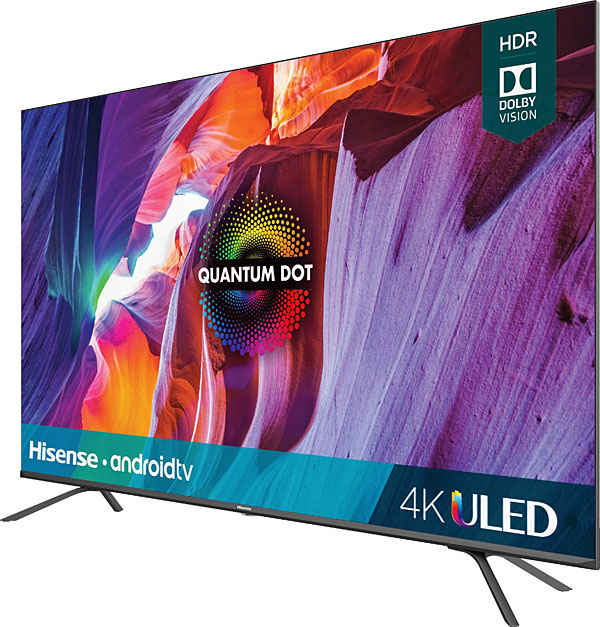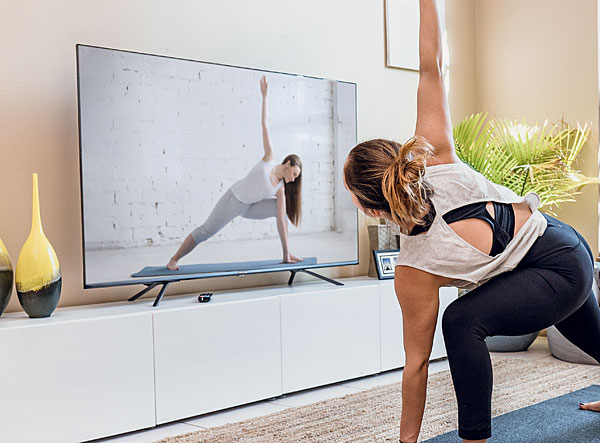Hisense 65H8G Quantum LCD Ultra HDTV Review Page 2
One final setup note: The 65H8G has a user control called HDMI 2.0 Format with both Standard and Enhanced settings. However, the TV won't maintain different settings of this control for SDR and HDR. It does so initially during setup, but then changes them after you switch from an SDR to an HDR source or vice versa. To avoid this issue, you should use the same setting for both SDR and HDR (I used Enhanced). Otherwise, the set retains your separate SDR and HDR picture settings and switches between them when you change source formats.
HD/SDR Performance
Except as noted, all of the SDR and HDR material used for this review was from Blu-ray and Ultra HD Blu-ray discs.
The 65H8G's performance on our standard video tests was superb, with the set upscaling 1080i sources to 4K with no jaggies artifacts or resolution loss. While its optical digital audio output delivered only 2.1 stereo instead of 5.1 soundtracks, there's always the set's HDMI ARC connection if you want to send full 5.1 surround sound to an A/V receiver.
The factory settings for Backlight and Contrast in the Theater Dark picture mode produced a peak white level of over 400 nits that was uncomfortably bright for SDR viewing. For calibration and viewing, I left the Backlight control at its default setting and decreased the Contrast control to 31, for an adjusted peak white level of around 45 ft-L (154 nits). I found this setting comfortable for viewing in either a darkened room or one with modest lighting, though with some sources I preferred to adjust the Contrast control a step or two higher.
The 65H8G's BT.1886 gamma setting was nearly ideal for most SDR sources, though a 2.2 setting worked better with a few. A subtle tweak I made to the Gamma Calibration adjustments (between +3 and +5) with the BT.1886 setting active made this rare control useful in avoiding crushed blacks.
The Hisense suffers significantly from the bane of many LCD TVs: off-center screen uniformity. Sit more than 20 degrees off to one side of center and color and contrast start to fade visibly. The set's Enhanced Viewing Angle feature helped a bit here, but not by much.

The 65H8G also suffers from vertical banding, though this artifact was clearly visible only with very dark gray video test patterns, and it's also the sort of issue that can vary from sample to sample of the same model. It never bothered me with real program material, though your mileage may differ.
When viewing from an optimal seating position, I found the 65H8G's calibrated SDR picture quality to be excellent. It didn't quite equal the jaw-dropping performance of the best, high-ticket sets I've recently tested, though it didn't lack for much. Local dimming was effective with only a few hiccups. For instance, when a source faded to black, the screen fully blacked out. And while the black bars on letterboxed films didn't consistently disappear completely in a fully darkened room, they were generally dark enough to ignore and did disappear in modest room lighting (which closes the pupils of your eyes enough to make it more difficult to distinguish between very dark gray and full black).
I also noted visible blooming in the image, mostly around bright objects against a dark background. And bright highlights next to a black bar on letterboxed films would bleed into the bar, though I didn't find the effect distracting.
In all other respects the Hisense's SDR performance was first-rate. Its crisp detail and rich color were fully evident on material as varied as the eye-opening royal banquet scene from the naturally photographed Victoria & Abdul, the sepia hues in The Mummy (from 1999, not the more recent, critically panned version), and the vivid-looking, but underappreciated animated film The Road to El Dorado.
UHD/HDR Performance
While the 65H8G doesn't reach the peak brightness capability of some premium sets on the market, our sample did hit around 600 nits in HDR mode—roughly equivalent to what you'll get from an OLED. And this was also after I backed off on the Contrast control for a more accurate result. (In its default setting the Hisense deviated from the standard PQ curve, with excessive output in the top half of its brightness range.)

Local dimming with HDR was similar to the SDR performance. Star fields didn't appear as jaw-dropping as what I'm used to seeing on an OLED TV, but with the controls set properly the screen dropped to near-total black on sources that allowed it. Letterbox bars looked dark but were visible in a fully darkened room (though, as with SDR, they often disappeared with room lighting), with adjacent bright objects occasionally bleeding into the bars. But the overall quality of Hisense's local dimming is remarkably close to that of sets priced much higher.
Onward, the latest animated feature from Pixar, isn't as vivid a disc as Coco or Inside Out, but it still generated a surprising range and depth of color on the Hisense. In the live action (mostly!) The Call of the Wild, a more subtle range of hues, not to mention the detail in the stunning scenic vistas of the Great White North (largely simulated, or so I've heard) were impossible to criticize.
While an HDR10 calibration was performed for this review, a Dolby Vision one was not. Nevertheless, after making no more than a several-step reduction of the Contrast control, Dolby Vision sources looked equally impressive. Both A Quiet Place and 1917, with its Academy Award-winning cinematography, were beautifully handled. And the challenging dark scenes in both films, particularly the final act in A Quiet Place, while less striking than what I'm used to seeing on an OLED, gave me no serious reason to complain.
Conclusion
You can spend a lot more for a new Ultra HDTV than the $800 you'll pay for Hisense's 65H8G, but the law of diminishing returns hasn't been repealed. In several weeks of testing and living with the 65H8G, did I miss my vintage-2017 OLED? In some ways, yes. But the highest praise I can give the Hisense is that, from the safety of my center seat, I never felt an irresistible urge to go back.




























































